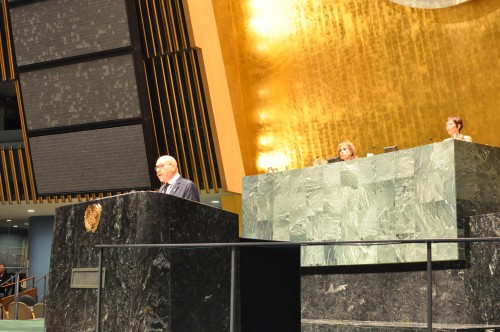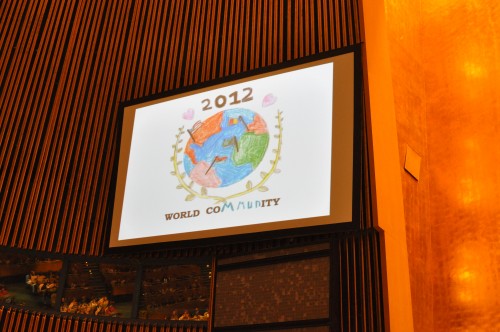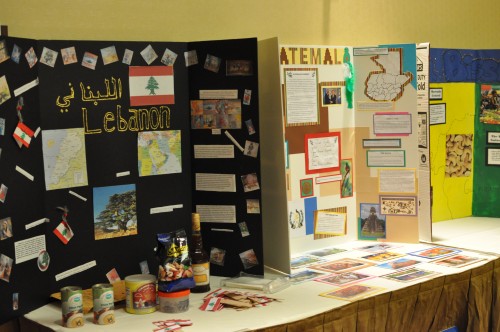The Montessori Model United Nations conference (MMUN) took place this past week in New York City. We tend to visit high school and college conferences, so it’s always refreshing and inspiring to visit a conference with students as young as 4th graders! Last year, we profiled the Montessori MUN conference and had Camille Moro, a Montessori graduate and current Model UN chairing superstar (she has staffed six conferences this semester including this one), write a reflection about her experience.
This year, I got to run a workshop titled “How to Support Your Students in their Model UN Journey.” The goal was to show how Model UN can be a journey of leadership development that is continued through high school and college and to show how teams build and train their clubs to prepare for those conferences. Many of the parents that attended my workshop didn’t realize that there were so many other conferences out there, that there are different educational philosophies among Model UN conferences and that most conferences see themselves as academic competitions rather than educational simulations (Montessori is definitely the latter), and that conferences even give awards!
Given this new information, my status as an outside observer (I was educated in public schools), and my own experience participating in competitive conferences, a few parents were very curious to know: what did I think about their children’s Montessori education in the context of Model UN? Here are five reasons why the Montessori method works in Model UN.
1. Montessori students learn cooperation and the art of compromise.
Maria Montessori believed in peace education and that philosophy plays itself out at the Montessori Model United Nations. The students learn cooperation and the art of compromise. A prime example came from a parent who I spoke with. Last year, her child was being more of a tough negotiator and didn’t really want to compromise. The child found out that he wasn’t able to work effectively with many delegates that way. This year, that same child learned that cooperation and compromise are much more effective in reaching consensus and his country’s goals. Cooperation was learned through the Montessori Model UN process, and success was tangible as the delegate was able to accomplish a lot more in committee and get much more support on his ideas.
This is in contrast with many other high school and college level conferences where awards are given out. The awards sometimes drive behavior in the sense that compromise is more of a tactic to win rather than for the sake of understanding someone else’s view points. Furthermore, the chairs at these conferences determine who wins awards. They judge how successful delegates were at compromising — success is defined externally rather than internally as illustrated in the Montessori example above.
2. Montessori students develop a connected network to support each other.
Montessori students learn in classrooms with mixed age groups and that’s the same format used at the Montessori Model UN conference; there are committees for 4-6 grades and committees for 7-9 grades. The importance here is that Montessori students develop connections with students from not only other schools but other grade levels as well. There’s much more collegiality between Montessori students from different schools and they form a global support network. That point was illustrated during Opening Ceremonies when Gregory MacDonald gave an example of how a Montessori alumna won the student council election in Australia by garnering support from other Montessori alumna at every grade level at her new high school. Watch the video below:
This is in slight contrast with awards-based Model UN at the high school level. Although teams are free to bring students from any grade to most conferences, teams oftentimes separate themselves by grade or experience level in order to have a better chance at winning at these competitions. For example, 9th graders may compete in an exclusively novice conference with other 9th graders, and teams may only allow their seniors or upperclassmen to travel to the most competitive conferences in the nation. This leads to more silo-ing between the grades. Some teams address this through mentoring systems where the upperclassmen are paired with a newer delegate, but this isn’t common. Regardless, many of these teams see each other as competitive rivals and they’re not as naturally inclined to support a student from another school as in the Australia example mentioned above.
3. Montessori students learn from the less structured, more self-directed environment.
Montessori students learn from a Constructivist or “discovery” model. That is, the environment is provided to them to learn but the lessons are not necessarily structured — students get to choose or figure out what and how they want to learn in this given environment. The part of the Montessori Model UN conference that this concept has the most noticeable impact in is during the Regular Caucus (also called unmoderated caucus at other conferences). Most delegates choose to spend their time during Regular Caucus to meet with other delegates to collaborate on their ideas and write a draft resolution — this is normal procedure at Model UN conferences. However, delegates are also free to do whatever else they want in order to creatively learn from their environment and from other students. Most notably, we’ve observed some students draw pictures of peace.
In contrast, most unmoderated caucuses at Model UN conferences seem more formal (although there are always students in the back of the room not actively participating). Students tend to be very active in draft resolutions and at some of the more competitive conferences it’s almost like a frenzy of delegates seeking allies, debating with others, and negotiating over ideas. Part of this is the competition, part of it is because others are so seriously involved in writing resolutions, and part of it is because the chairs tell delegates to stay “productive” — a narrower prescription that isn’t necessarily found in Montessori. At some competitive conferences, chairs are even trained to walk around the room to observe unmoderated caucus and keep track of who is doing well or tally up points when participation is scored (in fact, teachers complain when the chairs don’t walk around to enforce discipline). This forces delegates to use unmoderated caucus time for only writing resolutions instead of any other learning activities.
4. Montessori students learn about other cultures and about themselves.
The Montessori Model UN conference puts a big emphasis on more social activities where students can learn about other cultures and themselves — this fits with Montessori’s philosophy of psychological self-construction. This includes the traditional flag procession, the impressive country boards that are prepared before the conference and displayed throughout the conference, the social justice project, and the talent show. Montessori students are deliberately exposed to other cultures through the conference.
Most Model UN conferences tend to be more academic — the focus is on the issues and the committee experience rather than on learning about each other and the out-of-committee experiences. Rarely do students at the high school level focus on learning about other cultures during a Model UN conference. A few large conferences do buck this trend though and have extended programming such as a social justice project, a Global Village, tours, and other academic and social events.
5. Montessori produces young leaders with a can-do mentality.
Montessori currently can claim to be a big win as many of today’s tech giants were founded by Montessori alumni. This includes Larry Page and Sergey Brin of Google and Jeff Bezos of Amazon.com. Today’s leaders got their start at Montessori. The hope is that tomorrow’s leaders in the global political, economic, and social worlds — the areas of focus in Model United Nations — will also come from Montessori. Students as young as those in the fourth grade are already exposed to and trying to solve real world issues — issues that many of today’s world leaders have trouble solving. It’s quite impressive when one observes the debate sessions. These young students understand the issues, can communicate their country’s policies and viewpoints, and are able to debate on the merits of proposed solutions.
What I’ve noticed is that the later in life someone does Model UN, the less idealism those delegates have. That is, delegates at the college level have been exposed to some real-world challenges and principles and use those as restrictions for what they can’t do. Their resolutions tend to be much shorter than the relatively more idealistic resolutions presented at the high school level. In contrast, students at a younger age have more idealism and think about what we CAN do. It’s important that students address issues from a positive perspective, otherwise our world will just replicate its challenges and issues. Perhaps Montessori Model UN holds the key to doing so.
**
Here are some more photos from the conference:

Michael Jacobson, the Chair of the Montessori Model United Nations, welcomes delegates to the conference

Students representing different countries stand inside the United Nations General Assembly Hall during Opening Ceremonies

One of the two winning designs for the annual T-shirt contest is displayed in the UN General Assembly Hall
How Can I Learn More About Montessori Model UN?
Visit the Montessori Model UN website or our liveblog articles from last year:
- Montessori MUN Opening Ceremonies, Pledge to Earth, & 1/100th-size replica of the UN
- Montessori MUN Delegates in Action! Plus 4th graders talk though on…taxes?!
- Meet Montessori MUN Executive Director Judith Cunningham
- A Personal Reflection on Model UN & Montessori — Guest Post from Camille Moro
How Can My Child Continue His/Her Model UN Journey?
Several teachers and parents also asked me about the possibility of attending more conferences since their students are enjoying the Montessori MUN conference and would like to experience more similar events. I advocated that schools start hosting their own in-house conference or mock session and to perhaps even invite other local schools. Model UN is about student-led teaching — the students returning from the Montessori MUN conference should recruit and teach others at their school. Also, Montessori will be starting conferences in Europe and in the Midwest in the near future. But besides that, there is unfortunately nothing else out there that simulates Model UN for elementary school students. At the middle school level, our conferences database does list a few conferences run by UNA-USA Global Classrooms, local YMCA organizations, and a few universities. Middle school students can also sign up for our Model UN summer camp in California.





